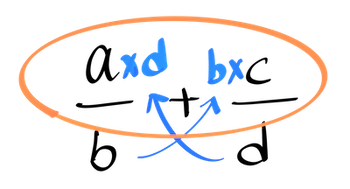Adding Fractions is finding their sum. In this class, we will learn how to add fractions covering multiple scenarios like adding two simple fractions, adding fraction and integer, adding mixed fractions, etc., with examples.
Adding two Simple Fractions
Consider two fractions of form a/b and c/d.
We have to find their sum: (a/b) + (c/d).
First, we will learn how to find the denominator of the sum, and then we will learn how to find the numerator of the sum.
Denominator
The denominator is the product of the denominators of the two given fractions.

Denominator = b*d
Numerator
The numerator is the sum of { product of first numerator (a) with second denominator (d), and the product of second numerator (c) with first denominator (b) }.

Numerator = a*d + b*c
Result
Therefore, the sum of the two fractions is
(a/b) + (c/d) == (a*d + b*c)/(b*d)
Example
1. Find the sum of the fractions 2/3 and 4/5.
Answer
Given:
First fraction a/b is 2/3.
Second fraction c/d is 4/5.
Formula:
Let us use the formula to find the sum of two fractions.
(a/b) + (c/d) == (a*d + b*c)/(b*d)
Calculation:
Substitute the values: a=2, b=3, c=4, d=5.
(2/3) + (4/5) == (2*5 + 3*4)/(3*5)
Simplify the right hand side expression.
(2/3) + (4/5) == (10 + 12)/15
(2/3) + (4/5) == 22/15
Therefore,
(2/3) + (4/5) == 22/15
Using LCM to Add two Fractions
Consider two fractions of form a/b and c/d.
We have to find their sum: (a/b) + (c/d).
Finding LCM
The Least Common Multiple (LCM) of two numbers is the smallest number that is a multiple of both.
For example, to find the LCM of 4 and 10, write down the multiples of both 4 and 10 as shown below.
- Multiples of 4: 4, 8, 12, 16, 20, 24, 28, 32, 36, 40, 44...
- Multiples of 10: 10, 20, 30, 40, 50, ...
The multiples that are common to both 4 and 10 are highlighted. They are 20, 40, and if you write more multiples of 4 and 10, you would get 60, 80, 100,...
But, LCM is the least of all these common multiples, which is 20
Therefore, the LCM of 4 and 10 is 20.
Finding Denominator
The LCM obtained in the previous step is the denominator for the sum of given fractions: (a/b) + (c/d).
Denominator = LCM of b and d
Denominator = LCM(b, d)
Numerator
The numerator of (a/b) + (c/d) using LCM is as shown below.
Numerator = (LCM(b,d)/b)*a + (LCM(b,d)/d)*c
Result
Therefore, the sum of the two fractions using LCM approach is
(a/b) + (c/d) == ((LCM(b,d)/b)*a + (LCM(b,d)/d)*c)/LCM(b,d)
Example
1. Find the sum of the fractions 3/4 and 7/10.
Answer
Given:
First fraction a/b is 3/4.
Second fraction c/d is 7/10.
Finding LCM of denominators:
Write the multiples of the two denominators: 4 and 10.
- Multiples of 4: 4, 8, 12, 16, 20, 24, 28, 32, 36, 40, 44...
- Multiples of 10: 10, 20, 30, 40, 50, ...
The least common multiple of the two denominators, LCM(4, 10) = 20.
Formula:
Let us use the formula to find the sum of two fractions.
(a/b) + (c/d) == ((LCM(b,d)/b)*a + (LCM(b,d)/d)*c)/LCM(b,d)
Calculation:
Substitute the values: a=2, b=3, c=4, d=5, LCM(b, d) = 20
(3/4) + (7/10) == (((20/4)*3)+((20/10)*7))/20
Simplify the right hand side expression.
(3/4) + (7/10) == ((5*3)+(2*7))/20
(3/4) + (7/10) == (15+14)/20
(3/4) + (7/10) == 29/20
Therefore,
(3/4) + (7/10) == 29/20
Adding a Fraction and an Integer
Consider a fraction of the form a/b and integer n.
We have to find their sum: (a/b) + (n).
First, we will learn how to find the denominator of the sum, and then we will learn how to find the numerator of the sum.
Denominator
The denominator is same as the denominator of the fraction.
Denominator = b
Numerator
The numerator is the sum of {numerator of given fraction (a), and the product of denominator (b) with the integer (n) }.
Numerator = a + b*n
Result
Therefore, the sum of the two fractions is
(a/b) + n == (a + b*n)/b
Example
1. Find the sum of the fraction 2/3 and the integer 4.
Answer
Given:
Fraction a/b is 2/3.
Integer n is 4.
Formula:
Let us use the formula to find the sum of a fraction and an integer.
(a/b) + n == (a + b*n)/b
Calculation:
Substitute the values: a=2, b=3, n=4.
(2/3) + 4 == (2 + 3*4)/3
Simplify the right hand side expression.
(2/3) + 4 == (2 + 12)/3
(2/3) + 4 == 14/3
Therefore,
(2/3) + 4 == 14/3